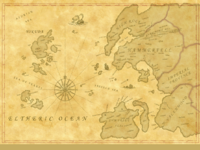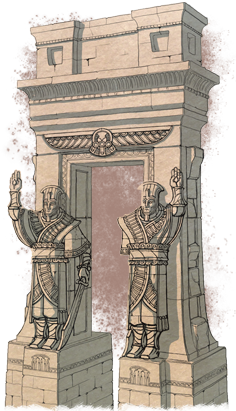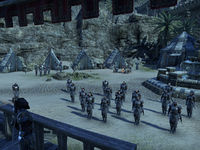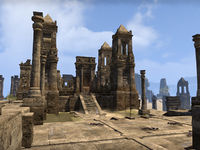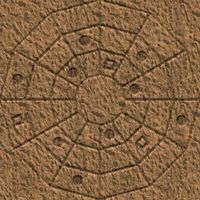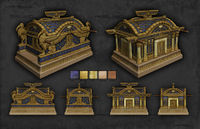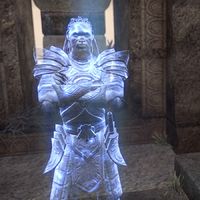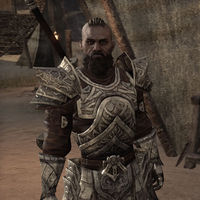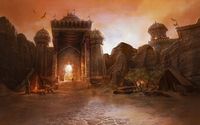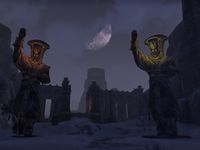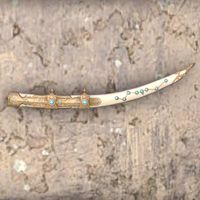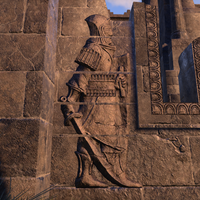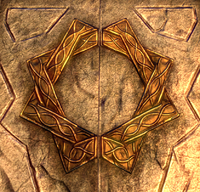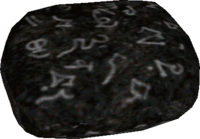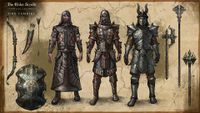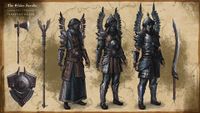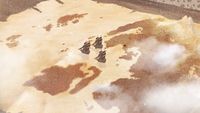Lore:Yokuda
| Yokuda | |
|---|---|
| Type | Continent |
| Continent | Yokuda |
| Demonym(s) | Yokudan |
Yokuda is a continent west of Tamriel which partially sank into the sea during the First Era.[1] It was the ancestral home of the Redguards, as well as a purportedly extinct Aldmeri race known as the Lefthanded Elves.[2] It was the birthplace of several famed Redguard heroes, including Frandar Hunding and his son Divad. It was also the nation that birthed the fabled martial tradition of sword-singing.[3] The native language of Yokuda was called Yoku, but after the Yokudan migration to Hammerfell in 1E 808, it was largely replaced to help stabilize foreign trade.[4]
Geography[edit]
Yokuda encompassed a number of islands within its domain, referred to as the Yokudan Isles.[5] These included Akos Kasaz, Bahia, Irranhu, Kanesh, Kardesh, Klithi, Samara, and Yath.[6][7] It is unknown whether the landmasses south of the Sea of Pearls, such as Ravan, are or were traditionally considered part of Yokuda.
The climate of Yokuda was said to be a desert, more arid than the Redguards' current province of Hammerfell, and covered with rocky, barren hills. Tremors of the earth were supposedly not uncommon in the continent's history.[8][9] Yokuda provided its people with a wealth of options for precious gemstones to mine from, allowing the Yokudans to refine their gem-cutting traditions even in spite of near-constant civil wars causing a shift on focus for utility over beauty. Their skills were carried over to Tamriel, where their Redguard descendants kept the traditions largely unchanged.[10]
The names of almost all nations, landmarks, cities, and provinces have been lost to history. The few that are known are:
- Arch: A great port city located in the province of Seawind. It was where the first warrior wave left Yokuda.[3]
- Hattu Mountain: Also known as the "Father of Mountains", it was where Hunding wrote the Book of Circles.[3][11]
- High Desert: The province known to be the ancestral home of Frandar Hunding.[3]
- Lumut: A settlement on Kanesh.[6]
- Makan: A settlement on Yath.[6]
- Saran: The birthplace of Rada al-Saran.[12][UOL 1]
- Tagon: A settlement on Akos Kasaz.[6]
- Taleskan: A settlement on Akos Kasaz.[6]
- Totambu: Yokuda's capital city was situated on Akos Kasaz, the largest island in the archipelago.[7]
- Yul: A settlement on Akos Kasaz.[6]
History[edit]
The origins of Yokuda is largely derived from ancient myths and legend. One creation myth suggests that Yokuda was once a part of Tamriel during the Dawn Era, but was ripped from the mainland and became a separate landmass after a destructive war among the Ehlnofey. After this destructive war, the Ehlnofey split into many different racial and aboriginal groups. The group of Ehlnofey that remained on Yokuda eventually became the Yokudans.[13]
Rule of the Na-Totambu[edit]
The ruling body of the Yokudan people was known as the Na-Totambu, a council of kings who represented the various nations of Yokuda. This system of government was ancient, dating back to the Merethic Era. During this time, legends speak of a thousand-year war against the Lefthanded Elves. The Na-Totambu fought to a standstill, but eventually won the war with aid from their gods Leki and Diagna.[2][14][15]
By the First Era, Yokuda had become a vast empire, and developed a tradition of being ruled by a single emperor, however this was eventually abolished in 1E 376. Although each successive emperor remained as the figurehead of the empire, his powers were very much reduced. As a result, the nation descended into three hundred years of continuous civil war between the provincial lords, warrior monks, and brigands, all fighting each other for land and power. These warlords, also known as Yokeda, built large stone castles to protect themselves and their lands. In time, towns began to grow outside these castle walls.[3]
Several centuries prior to 1E 660, Yokuda was ruled by Emperor Ardanan Haba. Groups of dissidents fled the empire for the islands to the east during his reign.[16]
Birth of the Sword-singers[edit]
- "Beyond the Sea of Pearls, peerless swordmasters were as common as grains of sand. Even the grandest victories felt commonplace.
- In a land of heroes, how can anyone claim to be exceptional?" — Rada al-Saran
The Yokudan people were once artisans, poets, mystics, and scholars, but the constant civil wars that plagued the nation resulted in many searching for enlightenment through the Way of the Sword. This eventually developed into a martial tradition known as sword-singing. Within a few generations, the Way of the Sword had become their life. Their poetry and artistry survived through the forging of beautiful swords woven with magic. The greatest among them became known as Ansei, or "Saints of the Sword". Ansei of the highest virtue wandered the countryside engaging in battle, righting wrongs, and seeking to end the strife.[3] Such was the influence of the Way to Yokudan life, that everyday items would have depictions of swords or warriors assuming fighting stances.[17][18][19]
In 1E 609, Mansel Sesnit became the Elden Yokeda, or military dictator. He waged many of the battles of unification and succeeded in gaining control of almost the entire empire until he was assassinated in 1E 617. His successor, Randic Torn, took over the government and continued the work of Sesnit. Torn revived the age-old gulf between the sword singers and the commoners by introducing restrictions on the wearing of swords. "Torn's Sword-Hunt", as it was known, meant that only the singers were allowed to wear swords, which distinguished them from the rest of the population. Although Torn did much to settle the empire into its pre-strife ways, by the time of his death in 1E 737 internal disturbances still had not been completely eliminated. After his death, another vicious civil war broke out.[3]
In the chaotic aftermath, Emperor Hira rose to power and attempted to wrestle control of the empire from the people by exterminating the sword-singers. The singers were few in number but rebelled against the persecution. This conflict became known as the War of the Singers. In 1E 780, it came to a climax at the foot of Hattu Mountain, where Frandar Hunding's army of singers crushed the emperor's forces. Following the victory, Frandar and his army left Yokuda on a flotilla of ships, and began their great migration across the Eltheric Ocean to Hammerfell. This marked the first of four documented migrations of the Ra Gada or "Warrior Wave".[20][3]
Destruction[edit]
Around 1E 792, the continent sank below the sea. It's debated whether the destruction that forced the Yokudans to flee was due to natural causes, acts of the Yokudans, or both. Yokuda was the scene of frequent warfare, and there are legends blaming the cataclysm on a rebel band of Ansei called the Hiradirge. The Hiradirge were said to be masters of "stone magic", and when they were defeated during the last civil war they took their revenge on the nation by using forbidden techniques reputedly capable of such devastation.[9] Indeed, the mortal incarnation of the Warrior constellation corroborated this legend when he claimed the Shehai of a first rank Ansei is what sank Yokuda.[21][nb 1] Further, some accounts claim that this forbidden sword stroke was called the "Pankratosword" - a maneuver that could destroy the very laws of nature.[UOL 2]
Other accounts, possibly related to the Hiradirge, speak of "Time of Ending" when the Yokudans fell away from the teachings of their gods. They conducted forbidden rites and "fell things were summoned that should never have been called forth". In response, Satakal emerged from the sea and Yokuda was pulled down beneath the waves.[22]
Remnants[edit]
While the majority of Yokuda was sunk, it still remains as island remnants. During the mid-Second Era, the onyx peak-mines of Hattu Mountain (located in the High Desert province) were supposedly still inhabited by Frandar Hunding cultists.[11] Several islands remained and were included on one late-Second Era map of West Tamriel. According to residents of Anvil during the late-Third Era, ships still sailed to Yokuda from Anvil,[23] and some texts referred to the continent as if it still exists in some form.[24]
Society[edit]
Religion[edit]
The Yokudan faith was built around the concept of Satakal consuming the world to begin another. They believed Satakal has done this many times over, a cycle which prompted the birth of spirits that could survive the transition, notably Ruptga, the first who learned how to do so. Ruptga set the stars in the sky to show lesser spirits how to do this, and these spirits ultimately became the Yokudan pantheon. Yokudan creation myth holds that they are doomed to mortality because they are very far away from the real world of Satakal, and the safe haven of the Far Shores is too far away for them to jump from the mortal world.[25][2][26]
Age of Progress[edit]
Yokudan society was very advanced for its time, and the nation birthed great advances in architecture, astronomy, martial arts, politics, and philosophy. Their innovation in the fields of metallurgy, agriculture, leatherworking, and shipbuilding were unknown even in modern times.[1]
Their advanced agricultural experience in the arid deserts of Yokuda was of great benefit when they migrated to the lesser deserts of Hammerfell.[9] They practiced ancient methods of metal-craft to forge their famed swords and armor. Their leather underwent a special curing process making it extremely durable, even after several centuries had passed.[27] Much of this knowledge was recorded in steel-plated tomes, such as the Cartulary of the Tamed Dunes, that they took with them to Hammerfell.[28][29] It is said that the Yokudans forgot more about steel-craft and desert survival than the Redguards ever learned.[30]
Much of the architectural style that dominates Hammerfell was directly transplanted from Yokuda.[31] Their architecture reflected their environment, and was designed to insulate from the desert's extremes of temperature.[8] Yokudan accent pieces, such as flying staircases or ornamental domes, were designed to crumble after an attack or an earthquake. This allowed them to be easily replaced in sections afterwards.[32] Their constructions frequently featured descriptive tablets to aid pilgrims.[30]
Yokudan culture was noted for its use of astrology, and some Yokudans were known to use sand maps that charted the constellations to determine if the souls of the dead would make their way to the Far Shores.[33] They associated the constellation of the Warrior and its charges with victory and success, and ancient legends speaks of travelers following the stars in the sky to reach the promised land.[34] Centuries later, the famed scholar Muhay at-Turna discovered that the legend was indeed true when he discovered the ruins of Kardala in Craglorn.[35][36]
Memory Stones were believed to originate in Yokuda.[9] These relics were used to record the thoughts and memories of the owner, and could be later retrieved. Many of these stones found their way into Hammerfell after the migration, but very few survived the following eras. The most notable was the memory stone of Makela Leki.[37][38] Yokudan navies were superior to those found among Tamrielic kingdoms.[39]
Legacy[edit]
Many Redguards, particularly the remnants of the Na-Totambu, revere and honor their Yokudan forefathers, and hold true many of their traditions and customs.[40] When the Crowns arrived in Hammerfell, they were determined to reproduce the culture of Yokuda as nearly as possible. They founded a city in the Alik'r and named it Na-Totambu after their old capital.[41] The ancient Yokudan pantheon of gods is still worshipped in parts of Hammerfell and numerous cults are dedicated to the various deities.[42] Some Redguards believe these traditions are being forgotten as the centuries pass, and seek to return to the old ways of Yokuda.[43][44] Conversely, some scholars view the Yokudans as nothing more than savage invaders who brutally suppressed the native people of Tamriel, and left nothing more than destruction in their wake.[45]
Although the Ra Gada brought over much knowledge in the form of books and scrolls, the vast majority of cultural records were lost in the cataclysm. The history and wisdom that did survive was stored in a temple known as the Seeker's Archive in Craglorn.[46][47][48] Nonetheless, their advancements in construction and craft was admired by other Tamrielic nations, who sought to imitate and perfect it.[32] During the mid-Second Era, countless artifact and relics of Yokudan origin could be found throughout Hammerfell.[49][50][51] Some of the more sacred relics were kept on display in various temples.[52] Various academic institutions, such as the Khefrem Academy of Yokudan Heritage and the Yokudan Heritage House in Hallin's Stand, were established to research the Yokudans and study translations of ancient texts.[53][47] According to legend, the assassin beetles of Hammerfell were said to originate on Yokuda. Known as "Samara Scarabs", they were originally much smaller, but grew into dangerous creatures as a warning from the gods as to not abandon their worship.[22] The Yokudan Charger breed of horse is said to be a direct descendant of the great gray war-horses Yaghoub brought in his fleet from Akos Kasaz.[54][55]
Notable Yokudans[edit]
- Rada al-Saran: An ancient Yokudan swordmaster before coming to Tamriel, he later acquired vampirism as the result of a meeting with Molag Bal, eventually becoming one of the most notable leaders of the Gray Host.[56][57]
- Ra Abah: Renowned Yokudan warrior who fought alongside Frandar Hunding in the War of the Singers against Emperor Hira. He was buried in the Valley of the Blades after his death. His teaching survived into at least the mid-Second Era.[58][59]
- Yokeda Razul: Fought alongside Divad Hunding, leading the Ra Gada to conquer the Alik'r. When the Na-Totambu and the Yokudan nobility came sometime after, Razul made himself Yokeda to cement the power of the Ra Gada. Some remember him as the first Forebear. He was buried in Tu'whacca's Throne after his death. He was briefly raised as an undead minion of the Withered Hand in 2E 582, but was defeated and laid to rest once more.[60]
- Grandee Yaghoub: The first of the Ra Gada to discover the Iliac Bay. He and his warrior-sailors landed in Hegathe and established the city of Sentinel.
- Emperor Tarish-Zi: Self-proclaimed emperor and leader of a warrior wave known as the Anka-Ra. His army cut a bloody swath across Hammerfell and all the way into Craglorn in their hunger to claim a new home.[61]
- Prince Hubalajad: A Na-Totambu noble who attempted to colonize Hew's Bane. Despite his best efforts, Hubalajad was foiled at every turn, and nearly all his endeavors resulted in failure.[62]
- The Four: The collective name for Ansei Mamireh, Akamon, Roshadon, and Rok'dun the Flame. Said to be prominent Yokudan warriors during the early Ra Gada invasions. According to legend, their prowess with the Shehai was unmatched and they single-handedly captured Nedic fortifications, breached walls and cut down entire armies.[63]
- King Xakhwan: Yokudan ruler circa 1E 853. Hailing from the island of Yath, he established colonies on the west coast of Hammerfell. He was killed by the Corelanya Clan in a conflict to drive them from Hammerfell and raised as an undead minion before being killed once more.
- Prince Maleel: Also known as the "Scythe of Yokuda", he was buried in the necropolis of Asakala alongside his generals, Sahdina the Scorpion and Rashomta the Spider.[64]
- King Ra Boshek: A supposed "evil usurper-king" who was interned in a mausoleum in Tu'whacca's Throne. His remains were disturbed by Flaccus Terentius around 2E 578 and were removed so that they could be re-consecrated under the Rite of Re-Interment.[32][65]
Gallery[edit]
-
Map of Yokuda around 1E 2260 (ESO)
See Also[edit]
Books[edit]
- Crafting Motif 20: Yokudan Style by Seeker's Archivist Ibrula — A description of Yokudan armor and weapons
- How the Yokudans Chased the Stars — The legend of the Star Man and his relationship to the Warrior constellation
- The Hunger of Sep by The Unveiled Azadiyeh, Songbird of Satakalaam — On the dangers of the Hunger of Sep
- The Lost Islands of Old Yokuda Attributed to Hazadiyya Sea-Queen — A poem dedicated to the islands of Yokuda
- The Na-Totambu of Yokuda — On the lost wisdom of Yokuda
- Redguards, History and Heroes by Destri Melarg — A summary of Redguard history, focusing on Frandar Hunding
- The Unearthing of Kardala by Muhay at-Turna — A scholar's notes surrounding his time with the Star-Gazers and the discovery of Kardala
- Varieties of Faith... by Brother Mikhael Karkuxor of the Imperial College — An expansive list of the pantheons and associated divine spirits of Tamriel's dominant cultures
Notes[edit]
- ^ This was further corroborated by the legendary swordmaster Rada al-Saran in a previous version of ESO, when he claimed that he could perform the cut that sundered Yokuda, however the line was later removed from the game for reasons unknown.
References[edit]
- ^ a b The Na-Totambu of Yokuda
- ^ a b c Varieties of Faith... — Brother Mikhael Karkuxor of the Imperial College
- ^ a b c d e f g h Redguards, History and Heroes — Destri Melarg
- ^ Pocket Guide to the Empire, 1st Edition: Hammerfell — Imperial Geographical Society, 2E 864
- ^ The Ubiquitous Sinking Isle — Lailfin, Steward of Histories at the Illumination Academy
- ^ a b c d e f Map of West Tamriel
- ^ a b The Lost Islands of Old Yokuda — Hazadiyya Sea-Queen
- ^ a b Crafting Motif 6: Redguard Style — Doctor Alfidia Lupus
- ^ a b c d Pocket Guide to the Empire, 3rd Edition: Other Lands — Imperial Geographical Society, 3E 432
- ^ Jewels of Yokuda — Master-Jeweler Donielle Geonette
- ^ a b Lefthander's Aegis Belt codex entry
- ^ Rada al-Saran's dialogue in ESO
- ^ The Annotated Anuad
- ^ Nilata Ruins loading screen in ESO
- ^ Yokudan King's dialogue in ESO
- ^ Systres History — Trilam Heladren, Associate Dean of Eltheric History, University of Gwylim
- ^ Yokudan Prayer Shawl contraband item in ESO
- ^ Woven Yokudan Rug contraband item in ESO
- ^ Yokudan Warrior Statuette contraband item in ESO
- ^ Divad the Singer — Destri Melarg
- ^ The Warrior's dialogue in ESO
- ^ a b The Hunger of Sep — The Unveiled Azadiyeh, Songbird of Satakalaam
- ^ Ulfgar Fog-Eye's dialogue in Oblivion
- ^ Pocket Guide to the Empire, 1st Edition: Prologue — Imperial Geographical Society, 2E 864
- ^ Tu'whacca, Arkay, Xarxes — Lady Cinnabar of Taneth
- ^ The Monomyth
- ^ From the notes of Emilja Snowmead, clothier — Emilja Snowmead
- ^ Cartulary of the Tamed Dunes item in ESO
- ^ The Book of Circles: Forging Maxims — Frandar Hunding
- ^ a b Paldeen's dialogue in ESO
- ^ Reverence for the Dead — Brother Opilio Congonius
- ^ a b c The Improved Emperor's Guide to Tamriel: Hammerfell — Flaccus Terentius, 2E 581
- ^ Save Hayle's Soul quest in Redguard
- ^ How the Yokudans Chased the Stars
- ^ The Unearthing of Kardala — Muhay at-Turna
- ^ Sanavar's Research Notes — Sanavar
- ^ From The Memory Stone of Makela Leki — Makela Leki
- ^ Cracked Yokudan Memory Stone contraband item in ESO
- ^ Pocket Guide to the Empire, 1st Edition: Cyrodiil — Imperial Geographical Society, 2E 864
- ^ Varieties of Faith, Crown Redguards — Brother Mikhael Karkuxor of the Imperial College
- ^ Lost City of the Na-Totambu loading screen in ESO
- ^ Safa al-Satakalaam's dialogue in ESO
- ^ Plea for Open Eyes — The Unveiled Azadiyeh
- ^ The Manifesto of Make Way
- ^ Blasius' Unfinished Manuscript — Blasius
- ^ Crafting Motif 20: Yokudan Style — Seeker's Archivist Ibrula
- ^ a b The Horse-Folk of Silverhoof — Doctor Nabeth al-Gilane, Khefrem Academy of Yokudan Heritage
- ^ Seeker's Archive loading screen in ESO
- ^ Old Yokudan Coin Collection contraband item in ESO
- ^ Ancient Yokudan Coin contraband item in ESO
- ^ Ancient Yokudan Relic contraband item in ESO
- ^ High Priest Zuladr's dialogue in ESO
- ^ Lady in the Cistern: Quen's Theory
- ^ Legend of the Yokudan Chargers — Honnorah af-Lahreq
- ^ Gray Yokudan Charger mount description in ESO
- ^ Count Verandis Ravenwatch's dialogue in ESO
- ^ Events of ESO: Greymoor
- ^ Sai Sahan's dialogue in ESO
- ^ Chronicles of the Five Companions 6 — Sai Sahan
- ^ Ramati at-Gar's dialogue in ESO
- ^ Warlords of the Ra Gada
- ^ In Defense of Prince Hubalajad — Lady Cinnabar of Taneth
- ^ This Text Property of Leki's Blade — Sima the Edged Scholar
- ^ Arch-Mage_Shalidor's dialogue in ESO
- ^ Note to Throne Keeper Farvad
Note: The following references are considered to be unofficial sources. They are included to round off this article and may not be authoritative or conclusive.
- ^ ZOS Correspondence
- ^ Lord Vivec's Sword-Meeting With Cyrus the Restless, The Imperial Library
|
||||||||||||||||||||
